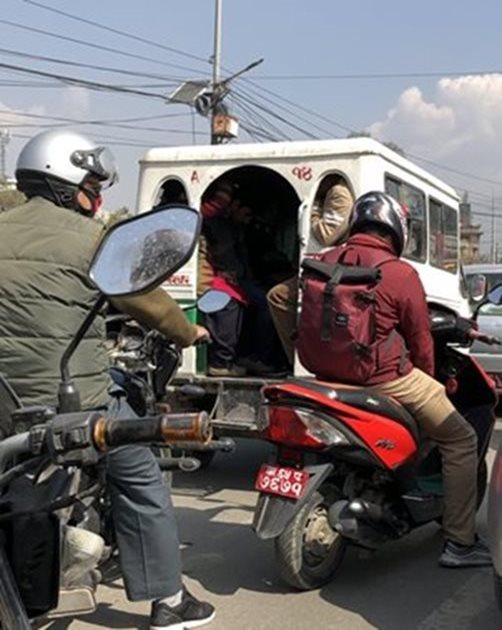Enough is enough. I aspire to having green credentials so why would I go to meet my friends by taxi? Rush hour was dwindling after all. My Russian white ladies’ town bicycle is the subject of many compliments and envious stares so she should be out on the streets.
I donned my helmet and totobobo mask and ventured out of the little alley where our flat is tucked away in Kupendol Height. As I tried to head out onto the main thoroughfare though I had to wobble between a tangle of fighting dogs, around a flower and leaf offering someone had left in the road and past a moped-rider who had randomly stopped to answer his phone. These are normal for Kathmandu. I was off, aiming north, towards Shivapuri on the rim of the Valley and the himals beyond.
The first challenge is the hill leading steeply down from the Summit Hotel where scooters and cars jostle to cut corners and squeeze by on a road with tight bends that should preclude overtaking, but doesn’t. There is a significant danger of being forced into a storm drain. I’ve long abandoned good manners when zooming down this hill as keeping in to the side of the road only encourages drivers to skim past then cut in. The rule of the road is that if you are in front – even if that is because of some kamikaze move – you have right of way. The other rule is cyclists are fair game and should give way to all other traffic. Might is right.
So far today though, everything is easy and I’ve successfully negotiated all potholes, goats and sleeping cows until I join the main road at Pul Chowk. It is past 10am but the road is congested, with two lanes of stationary vehicles in both directions; the air is thick with fumes, dust and the stench of the holy Bagmati River.
I skilfully wiggle between scooters and join the slow moving traffic, trying to keep so tight into the side of the road so that no-one can undertake me, but it doesn’t work. I’m scuppered by a motorbike doing a u-turn for no obvious reason. I’m undertaken by two motorbikes driving in the gutter. Then I am stuck behind an old man (he’s probably younger than me) on a bicycle packed with an unbelievable number of boxes and with bags dangling from handlebars. He is progressing slower than walking pace. Mopeds are so thickly packed I struggle to get past him. Moped handlebars or wing-mirrors come within centimetres of my handlebars and elbows, and weave in front so close to my front wheel I have to break often.
I am at an advantage at the traffic lights though. Trucks and cars are kept in order by traffic police wearing face masks. Scooters and motorbikes undertake the larger vehicles and line up at the front of the jam and I sneak past all of them and await the police officer’s whistle and the start of the race across the junction. The challenge is that traffic is merging from the left and doesn’t give way to traffic driving straight on but it isn’t possible to stop either. The technique seems to be to peddle as furiously as possible and weave and thread between the trucks and buses and taxis and cars and motorbikes until I’ve made it back to the relative safety of the road-edge. Even so at any small junction, office or home there is a good chance of a scooter joining the traffic without looking. They come out, full speed, hand on horn assuming everyone will give way.
Horns are used a lot on Nepal: when starting the engine, when pulling out recklessly, when overtaking, when passing vehicles going in the other direction, on coming around a corner and when simply saying hello. If there is a hazard, the reaction isn’t to break but to horn-honk.
Whenever I head out into Kathmandu I debate in my head whether cycling in the city should be declared an extreme sport. It certainly feels sporting and requires a different level of concentration and alertness than cycling in Cambridge: at times here, it is possible to be confronted by vehicles coming at you from six different directions. Crossroads are the biggest challenge. There is no point waiting for your turn to cross – it will never come – but when you do push into the thick of the traffic, where people will be cutting corners on the wrong side of the road, all you can do is look determined and try to keep going.
The great thing is that urban traffic is all very slow-moving and good-natured. No-one actually wants to kill you (which doesn’t always feel the case in England) and impacts are generally trivial and don’t result in injury. Fingers crossed.
 |
| Imbibing fresh Himalayan air in a Kathmandu jam |